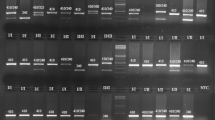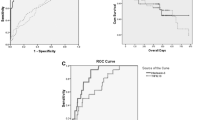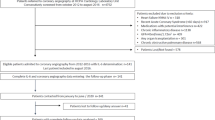Abstract
This study aims to investigate the relationship between the levels of IL-18, IL-10, and MMP-9 and -137G/C polymorphism of interleukin 18 with the risk of in-stent restenosis (ISR). The study population consisted of 68 patients with ISR, 173 in non-ISR group, treated with drug-eluting stent and evaluated by coronary angiography post-procedure and at follow-up, and also 109 without angiographic evidence of coronary artery disease (CAD) which formed a reference control group (non-CAD group). The sequential plasma IL-18, IL-10, and MMP-9 levels were assessed at admission, 24 h, and 2 weeks after percutaneous coronary intervention. The -137G/C polymorphism of IL-18 was genotyped by the ligase detection reaction-polymerase chain reaction. Plasma IL-18 and MMP-9 increased significantly from admission, peaking after 24 h and fall after 2 weeks. Compared with the non-ISR group, the ISR group had higher levels of IL-18 and MMP-9, but IL-10 level was the opposite. The -137GG genotype of IL-18 was significantly higher than of the CG and CC genotypes. A significant higher frequency of -137G allele or GG genotype of IL-18 was observed in patients with ISR group compared with the non-ISR group. There is correlation between the changes of IL-18, IL-10, MMP-9, and ISR. IL-18 promoter -137G/C polymorphism influences IL-18 levels and the susceptibility to ISR, suggesting that IL-18-mediated pathways are causally involved in the process of ISR.

Similar content being viewed by others
REFERENCES
Libby, P., P.M. Ridker, and A. Maseri. 2002. Inflammation and atherosclerosis. Circulation 105: 1135–1143.
Mulvihill, N.T., and J.B. Foley. 2002. Inflammation in acute coronary syndromes. Heart 87: 201–204.
Hansson, G.K. 2005. Inflammation, atherosclerosis, and coronary artery disease. N Engl J Med 352: 1685–1695.
Packard, R.R., and P. Libby. 2008. Inflammation in atherosclerosis: from vascular biology to biomarker discovery and risk prediction. Clin Chem 54: 24–38.
Zernecke, A., E. Shagdarsuren, and C. Weber. 2008. Chemokines in atherosclerosis: an update. Arterioscler Thromb Vasc Biol 28: 1897–1908.
Reddy, P. 2004. Interleukin-18: recent advances. Curr Opin Hematol 11: 405–410.
Stoll, S., H. Jonuleit, E. Schmitt, et al. 1998. Production of functional IL-18 by different subtypes of murine and human dendritic cells(DC): DC-derived IL-18 enhances IL-12-dependent Th1 development. Eur J Immunol 28: 3231–3239.
Bobryshev, Y.V. 2000. Dendritic cells and their involvement in atherosclerosis. Curr Opin Lipidol 11: 511–517.
Gerdes, N., G.K. Sukhova, P. Libby, et al. 2002. Expression of interleukin (IL)-18 and functional IL-18 receptor on human vascular endothelial cells, smooth muscle cells, and macrophages; implications for atherogenesis. J Exp Med 195: 245–257.
Maffia, P., G. Grassia, P. Di Meglio, et al. 2006. Neutralization of interleukin-18 inhibits neointimal formation in a rat model of vascular injury. Circulation 114: 430–437.
Chandrasekar, B., K. Vemula, R.M. Surabhi, et al. 2004. Activation of intrinsic and extrinsic proapoptotic signaling pathways in interleukin-18-mediated human cardiac endothelial cell death. J Biol Chem 279: 20221–20233.
Chandrasekar, B., A.J. Valente, G.L. Freeman, et al. 2006. Interleukin-18 induces human cardiac endothelial cell death via a novel signaling pathway involving NF-kappaB-dependent PTEN activation. Biochem Biophys Res Commun 339: 956–963.
Chandrasekar, B., S. Mummidi, L. Mahimainathan, et al. 2006. Interleukin-18-induced human coronary artery smooth muscle cell migration is dependent on NF-kappaB- and AP-1-mediated matrix metalloproteinase-9 expression and is inhibited by atorvastatin. J Biol Chem 281: 15099–15109.
Whitman, S.C., P. Ravisankar, and A. Daugherty. 2002. Interleukin-18 enhances atherosclerosis in apolipoprotein E(−/−) mice through release of interferon-gamma. Circ Res 90: E34–E38.
de Nooijer, R., J. von der Thusen, C.J. Verkleij, et al. 2004. Overexpression of IL-18 decreases intimal collagen content and promotes a vulnerable plaque phenotype in apolipoprotein-E-deficient mice. Arterioscler Thromb Vasc Biol 24: 2313–2319.
Tiret, L., T. Godefroy, E. Lubos, et al. 2005. Genetic analysis of the interleukin-18 system highlights the role of the interleukin-18 gene in cardiovascular disease. Circulation 112(5): 643–650.
Giedraitis, V., B. He, W.X. Huang, et al. 2001. Cloning and mutation analysis of the human IL-18 promoter: a possible role of polymorphisms in expression regulation. J Neuroimmunol 112(1–2): 146–152.
Liu, W., Q. Tang, H. Jiang, et al. 2009. Promoter polymorphism of interleukin-18 in angiographically proven coronary artery disease. Angiology 60(2): 180–185.
Grutz, G. 2005. New insights into the molecular mechanism of interleukin-10-mediated immunosuppression. J Leukoc Biol 77: 3–15.
Nishihira, K., T. Imamura, A. Yamashita, et al. 2006. Increased expression of interleukin-10 in unstable plaque obtained by directional coronary atherectomy. Eur Heart J 27: 1685–1689.
Galis, Z.S., G.K. Sukhova, M.W. Lark, and P. Libby. 1994. Increased expression of matrix metalloproteinases and matrix degrading activity in vulnerable regions of human atherosclerotic plaques. J Clin Invest 94: 2493–2503.
Blankenberg, S., H.J. Rupprecht, O. Poirier, C. Bickel, and F. Cambien. 2003. Tiret L:Plasma concentrations and genetic variation of matrix metalloproteinase 9 and prognosis of patients with cardiovascular disease. Circulation 107: 1579–1585.
Miller, S.A., D.D. Dykes, and H.F. Polesky. 1988. A simple salting out procedure for extracting DNA from human nucleated cells. Nucleic Acids Res 16(3): 1215.
Gaunt, T.R., S. Rodriguez, and I.N. Day. 2007. Cubic exact solutions for the estimation of pairwise haplotype frequencies: implications for linkage disequilibrium analyses and a web tool ‘Cubex’. BMC Bioinform. 8: 428.
Hoffmann, R., and G.S. Mintz. 2000. Coronary in-stent restenosis-predictors, treatment and prevention. Eur Heart J 21: 1739–1749.
Mitra, A.K., and D.K. Agrawal. 2006. In stent restenosis: bane of the stent era. J Clin Pathol 59: 232–239.
Shah, S.H., E.R. Hauser, D. Crosslin, et al. 2008. ALOX5AP variants are associated with in-stent restenosis after percutaneous coronary intervention. Atherosclerosis 201(1): 148–154.
Oguri, M., K. Kato, T. Hibinot, et al. 2007. Identification of a polymorphism of UCP3 associated with recurrent in-stent restenosis of coronary arteries. Int J Mol Med 20: 533–538.
Miranda-Malpica, E., M.A. Martinez-Rios, J.M. Fragoso, et al. 2008. The interleukin 1B-511 polymorphism is associated with the risk of developing restenosis after coronary stenting in Mexican patients. Hum Immunol 69: 116–121.
Okamura, H., H. Tsutsui, S. Kashiwamura, et al. 1998. Interleukin-18: a novel cytokine that augments both innate and acquired immunity. Adv Immunol 70: 281–312.
Szmitko, P.E., C.H. Wang, R.D. Weisel, et al. 2003. New markers of inflammation and endothelial cell activation: partI. Circulation 108: 1917–1923.
Mallat, Z., A. Corbaz, A. Scoazec, et al. 2001. Expression of interleukin-18 in human atherosclerotic plaques and relation to plaque instability. Circulation 104: 1598–1603.
Chandrasekar, B., S. Mummidi, L. Mahimainathan, et al. 2006. Interleukin-18-induced human coronary artery smooth muscle cell migration is dependent on NF-kB- and AP-1-mediated matrix metalloproteinase-9 expression and is inhibited by atorvastatin. Biol Chem 281: 15099–15109.
Liang, X.H., W. Cheung, C.K. Heng, et al. 2005. Reduced transcriptional activity in individuals with IL-18 gene variants detected from functional but not association study. Biochem Biophys Res Commun 338: 736–741.
Laurent, J., L.J. Feldman, L. Aguirre, et al. 2000. Interleukin-10 inhibits intimal hyperplasia after angioplasty or stent implantation in hypercholesterolemic rabbits. Circulation 101: 908–916.
Author information
Authors and Affiliations
Corresponding author
Rights and permissions
About this article
Cite this article
Liu, W., Liu, Y., Jiang, H. et al. Plasma Levels of Interleukin 18, Interleukin 10, and Matrix Metalloproteinase-9 and -137G/C Polymorphism of Interleukin 18 Are Associated with Incidence of In-stent Restenosis After Percutaneous Coronary Intervention. Inflammation 36, 1129–1135 (2013). https://doi.org/10.1007/s10753-013-9647-6
Published:
Issue Date:
DOI: https://doi.org/10.1007/s10753-013-9647-6




